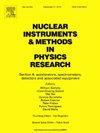双激光跟踪系统在粒子加速器密闭空间中的坐标传递方法研究
IF 1.4
3区 物理与天体物理
Q3 INSTRUMENTS & INSTRUMENTATION
Nuclear Instruments & Methods in Physics Research Section A-accelerators Spectrometers Detectors and Associated Equipment
Pub Date : 2025-07-24
DOI:10.1016/j.nima.2025.170901
引用次数: 0
摘要
针对粒子加速器等大型科学设备能见度有限、空间狭窄等实际应用场景,通过将靶球磁性附着在激光跟踪仪的测量头上,实现了两种仪器激光束基线的搭配,并构建了坐标系转换的求解模型。提出了两种方法:第一,构建基于重力的坐标系,建立与水平面的对中关系,使仪器的定位完全通过相互观测实现,而不使用公共点;其次,在非调平条件下,通过标定或消除探测目标球的初始位置来构建观测方程,并结合中间视场的公共点约束实现坐标系的统一;本文以粒子加速器实验大厅与存储环控网通过观察孔连接为应用场景,并进行相关实验验证。结果表明,在8 m距离处,重力坐标系法与传统的共点转换法旋转角度差小于0.004°,点均方根精度为0.271 mm。非调平状态下三轴旋转角度差值小于0.005°,点均方根值分别为0.259 mm和0.224 mm。两种方法均能实现高精度的坐标转换,具有一定的工程应用价值。本文章由计算机程序翻译,如有差异,请以英文原文为准。
Research on the methods of coordinate transfer of dual-laser-tracker system in the confined space of particle accelerator
Aiming at the practical application scenarios of particle accelerators and other large scientific devices, such as limited visibility and narrow space, this paper realises the collocation of the laser beam baselines of the two instruments through the target sphere magnetically attached to the measuring head of the laser tracking instrument, and constructs a solution model for the transfer of the coordinate system. Two methods are proposed: First, a gravity-based coordinate system is constructed to establish alignment with the horizontal plane, enabling instrument orientation solely through mutual observations without the use of common points. Second, under the unlevelled condition, the observation equations are constructed by calibrating or eliminating the initial position of the probe target sphere, and the unification of the coordinate system is achieved by combining the common point constraints in the middle field of view. This paper takes the connection between the particle accelerator experimental hall and the storage ring control network through the viewing hole as the application scenario, and conducts relevant experimental verification. The results show that at a distance of 8 m, the difference in rotation angle between the gravity coordinate system method and the traditional common point conversion is less than 0.004°, and the point root mean square (RMS) accuracy is 0.271 mm. The difference in the three-axis rotation angle under the unlevelled condition is less than 0.005°, and the point RMS is 0.259 mm and 0.224 mm, respectively. Both methods can achieve high accuracy coordinate transfer and have certain engineering application value.
求助全文
通过发布文献求助,成功后即可免费获取论文全文。
去求助
来源期刊
CiteScore
3.20
自引率
21.40%
发文量
787
审稿时长
1 months
期刊介绍:
Section A of Nuclear Instruments and Methods in Physics Research publishes papers on design, manufacturing and performance of scientific instruments with an emphasis on large scale facilities. This includes the development of particle accelerators, ion sources, beam transport systems and target arrangements as well as the use of secondary phenomena such as synchrotron radiation and free electron lasers. It also includes all types of instrumentation for the detection and spectrometry of radiations from high energy processes and nuclear decays, as well as instrumentation for experiments at nuclear reactors. Specialized electronics for nuclear and other types of spectrometry as well as computerization of measurements and control systems in this area also find their place in the A section.
Theoretical as well as experimental papers are accepted.

 求助内容:
求助内容: 应助结果提醒方式:
应助结果提醒方式:


